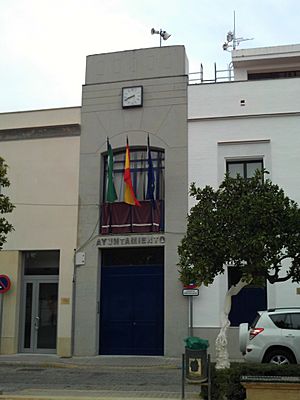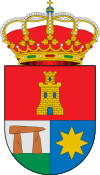Valencina de la Concepción facts for kids
Quick facts for kids
Valencina de la Concepción, Spain
|
|||
|---|---|---|---|

Valencina de la Concepción town hall
|
|||
|
|||
| Country | Spain | ||
| Province | Seville | ||
| Municipality | Valencina de la Concepción | ||
| Area | |||
| • Total | 25 km2 (10 sq mi) | ||
| Population
(2018)
|
|||
| • Total | 7,803 | ||
| • Density | 312/km2 (808/sq mi) | ||
| Time zone | UTC+1 (CET) | ||
| • Summer (DST) | UTC+2 (CEST) | ||
Valencina de la Concepción is a town in Andalusia, Spain. It is located in the province of Seville. In 2018, about 7,800 people lived there. This town is famous for its important ancient discoveries.
Contents
Romería de Torrijos Festival
Every year, on the second Sunday of October, Valencina de la Concepción celebrates a special public holiday. It is called "Romería de Torrijos". This festival is a pilgrimage to the sanctuary of Torrijos.
People carry a statue of the town's patron saint, the Virgin, in a procession. Many pilgrims join in, riding in decorated carriages or on horseback. When the Virgin arrives at the Torrijos Hacienda, a special mass is held. This is a very important pilgrimage for the Aljarafe area.
Ancient History of Valencina
Valencina de la Concepción is home to a very large Chalcolithic site. The Chalcolithic period is also known as the Copper Age. This site is one of the biggest in Spain.
In Valencina, there are two famous ancient tombs called dolmens. These are the dolmen of Matarrubilla and the Dolmen de la Pastora. A dolmen is a type of tomb made from large stones. It has several upright stones that hold up a flat, heavy capstone. Many of these tombs were built before 3000 BC.
Originally, these dolmens were covered with earth to create a mound, called a barrow. Over time, the soil has worn away. Now, only the large stones of the graves remain.
Important Discoveries in Ancient Tombs
Two tombs in the Valencina area have led to major new understandings in archaeology. One tomb, called the Tholos de Montelirio, was very elaborate. It contained many valuable items. Evidence suggests the person buried there was a cultural leader. People honored this leader for many decades after their death.
Another tomb was simpler but also contained items showing high social status. Both tombs were carefully studied by archaeologists. In 2023, scientists used a new method to analyze dental enamel. This method allowed them to accurately identify the gender of the people buried.
The new scientific analysis showed that both of these important tombs belonged to women. This discovery has completely changed how experts view the ancient culture. It might also lead to new interpretations of other ancient finds. In the past, gender was often guessed, which could have led to wrong ideas about these old societies.
The woman from the elaborate tomb is now known as "the Ivory Lady" in scientific discussions. She is considered the most important person found from the Copper Age cultures of the Iberian Peninsula. These cultures existed between 3200 and 2500 BC. This was around the same time that ancient Egyptian and Mesopotamian cultures were growing and thriving.
Archaeological evidence from 2500 BC also shows that Valencina was a major center for smelting copper. This means people here were skilled at melting copper ore to make metal tools and objects.
Images for kids
-
Dolmen de la Pastora entrance
See also
 In Spanish: Valencina de la Concepción para niños
In Spanish: Valencina de la Concepción para niños






